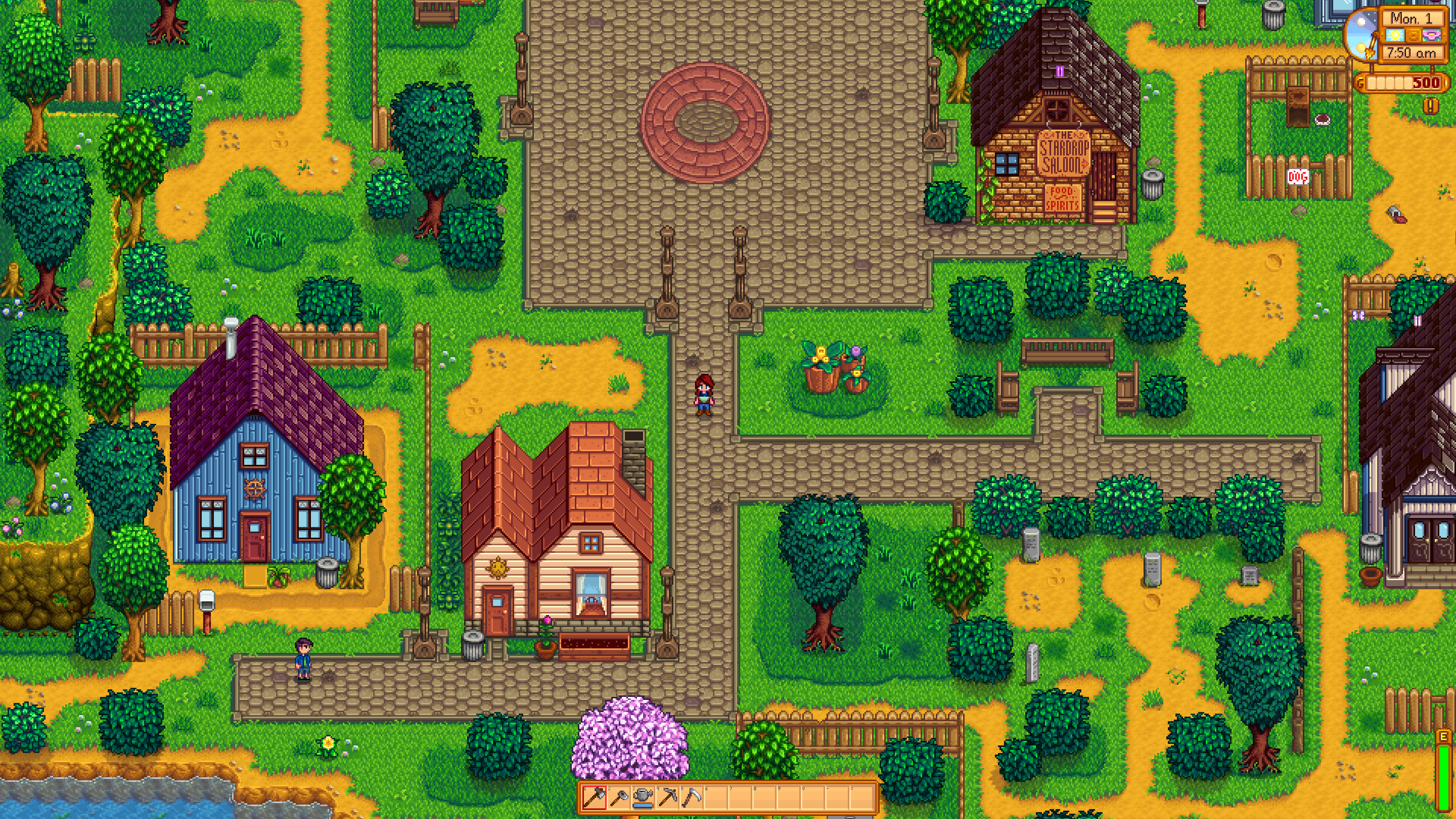
- 1. Graveyard Keeper
- 2. My Time at Sandrock (sequel to My Time at Portia)
- 3. Doraemon Story of Seasons: Friends of the Great Kingdom
- 4. Slime Rancher 2
- 5. Moonlighter
- 6. Dragon Quest Builders 2
- 7. Coral Island
- 8. Garden Story
- 9. Hokko Life
- 10. Animal Crossing: New Horizons (Nintendo Switch Exclusive)
- 11. Disney Dreamlight Valley
- 12. Kynseed
- 13. Harvest Moon
- 14. Sunhaven
- 15. Ooblets
Best Games Like Stardew Valley: Our Picks for 2023 (Farming Games and Other Similar Games)
Stardew Valley has become a beloved farming simulation game since its release. Its charming art style, relaxing gameplay, and captivating story have captured the hearts of players worldwide. If you’re a fan of Stardew Valley and are looking for similar experiences, you’re in luck. There are several games that offer the same delightful gameplay and immersive worlds. Here, we’ll explore the best games like Stardew Valley and new farming games that are worth trying in 2023.
Disclaimer: This page contains affiliate links. We may earn a commission if you purchase through these links, at no additional cost to you.
SEE ALSO: The Best Gaming Chairs for Back Pain
What Are the Best Games Similar to Stardew Valley?
When it comes to games like Stardew Valley, there are several standout titles that capture the essence of farming and life simulation. One such game is Slime Rancher, where players run their own ranch, care for adorable slimes, and explore a vibrant, open world filled with quirky creatures and mysteries. Another captivating title is Story of Seasons, previously known as Harvest Moon, offering players the chance to build and manage their farm while developing relationships with the townsfolk. Additionally, My Time at Portia and its sequel My Time at Sandrock provide a rich world for players to explore, mine, farm, and build relationships in a charming post-apocalyptic setting.
Purchase Stardew Valley for Switch
Our Favorite Games Like Stardew Valley on PC and Console, Ranked
Best Farming Games Like Stardew Valley Frequently Asked Questions
Which New Farming Games Are Worth Trying in 2023?
While Stardew Valley continues to captivate players, there are new farming games making waves in 2023. Pioneers of Olive Town offers a compelling farming experience on the Nintendo Switch, allowing players to cultivate their farm, raise animals, and explore a vast world filled with opportunities. On the other hand, Disney Dreamlight Valley introduces a magical farming world inspired by beloved Disney characters, delivering a delightful experience for players of all ages. Furthermore, Coral Island is an upcoming farming RPG, promising an enchanting journey of agriculture, romance, and adventure on a secluded island.
Is Dinkum a farm sim similar to Stardew Valley?
While Dinkum is similar to Stardew Valley, there is not enough content at the moment for our editors to recommend the game. It seems promising though and we will check back in the future!
Are There Any Upcoming Releases Comparable to Stardew Valley?
Looking ahead, there are exciting upcoming releases that bear resemblance to Stardew Valley’s charm and gameplay. The highly anticipated sequel, Slime Rancher 2, is set to continue the legacy of ranching and exploration with new slimes and locations. My Time at Sandrock is another title to watch out for, offering a new desert setting where players can farm, build relationships, and unravel ancient mysteries. Additionally, Kynseed invites players to embark on a whimsical adventure where they can farm, craft, and build a lasting legacy in a mystical world.
What Other Life Simulation Games Are Available Besides Stardew Valley?
Besides the farming and life simulation genre, there are other captivating games that offer immersive experiences akin to Stardew Valley. Doraemon: Story of Seasons combines beloved Doraemon characters with the gameplay of Story of Seasons, providing a heartwarming farming adventure. Meanwhile, Garden Story presents players with the task of restoring a fragmented community and tending to a vibrant garden as the newly appointed village guardian. Furthermore, Animal Crossing: New Horizons offers a laid-back island life simulation where players can customize their surroundings, make friends, and create their own paradise.
How Do These Games Compare to Stardew Valley in Terms of Gameplay?
When comparing these games to Stardew Valley, it’s evident that they share certain similarities while also offering distinct features and mechanics.
Similarities to Stardew Valley’s Farming and Life Simulation Elements
Most of these games, like Slime Rancher and Story of Seasons, include farming mechanics, relationship building, and exploration similar to that in Stardew Valley. Players can expect to cultivate crops, raise animals, and engage with NPCs to progress in the game.
Differences in Storyline and Quests
Each game, such as My Time at Portia and Coral Island, presents unique storylines and quests that set them apart from Stardew Valley. While they retain the essence of farming and life simulation, the narratives and objectives vary, offering players diverse experiences.
Unique Features and Mechanics
Furthermore, games like Pioneers of Olive Town and Disney Dreamlight Valley incorporate their own unique features and mechanics, such as special events and character interactions, enhancing the overall gameplay experience and adding depth to the farming simulation genre.
Q: What are some games similar to Stardew Valley?
A: Some games similar to Stardew Valley are Slime Rancher, Story of Seasons, Time at Portia, Moonlighter, Coral Island, and Animal Crossing: New Horizons.
Q: Can you recommend some life simulation games like Stardew Valley on PC?
A: Yes, some recommended life simulation games like Stardew Valley on PC are Slime Rancher, Pioneers of Olive Town, Garden Story, and Kynseed.
Q: Are there any farming games similar to Stardew Valley available on Nintendo Switch?
A: Yes, some farming games similar to Stardew Valley available on Nintendo Switch are Doraemon Story of Seasons, Coral Island, and Moonlighter.
Q: What are the best games like Stardew Valley that feature farming and town management?
A: The best games similar to Stardew Valley that feature farming and town management are Slime Rancher 2, Graveyard Keeper, and Time at Portia.
Q: Are there any pixelated farming simulation games like Stardew Valley?
A: Yes, some pixelated farming simulation games like Stardew Valley are Story of Seasons: Friends of Mineral Town and Stardew Valley itself.
Q: Can I find games like Stardew Valley with a focus on growing crops and managing a farm on PC?
A: Yes, you can find games like Stardew Valley with a focus on growing crops and managing a farm on PC, such as Slime Rancher, Moonlighter, and Dinkum.
Q: What games similar to Stardew Valley are available in early access?
A: Some games similar to Stardew Valley available in early access are Time at Sandrock and Pioneers of Olive Town.
Q: Are there any games like Stardew Valley with a cosy and relaxing atmosphere?
A: Yes, there are games like Stardew Valley with a cosy and relaxing atmosphere, such as Coral Island, Kynseed, and Garden Story.
Q: Can you recommend games similar to Stardew Valley that feature foraging and befriending characters?
A: Some games similar to Stardew Valley that feature foraging and befriending characters are Slime Rancher, Graveyard Keeper, and Story of Seasons.
Q: What are the best management games similar to Stardew Valley?
A: The best management games similar to Stardew Valley are Dinkum, Moonlighter, and Time at Portia.
In the ever-growing world of farming games, fans of Stardew Valley have no shortage of options to indulge in similar gameplay, each with its unique charm and style. From the cozy, pixelated worlds of Coral Island and Garden Story to the medieval cemetery management sim of Graveyard Keeper, these games entice players with their own take on Stardew’s farming and town life mechanics. Games like Moonlighter and Disney Dreamlight Valley, while offering a bit more combat and adventure, still retain that relaxing and rewarding farming sim RPG loop. For those who prefer the gameplay of Stardew Valley but on PC or Nintendo Switch, titles like My Time at Sandrock and the Story of Seasons series, including Pioneers of Olive Town and Friends of Mineral Town, provide a similar art style and engaging experience. Whether you’re tasked with building up a plot of land, harvesting crops, or nurturing little slimes in Slime Rancher 2, these games keep you busy with changing seasons, growing crops, and interacting with townsfolk. So, for fans of Stardew Valley, whether you’re looking for games with a similar art style, a cosy atmosphere like Animal Crossing, or just the best management games available on PC and consoles, this list of the best Stardew Valley-like games offers plenty of choices to grow crops, befriend NPCs, and forage to your heart’s content.
About the Author
Written by Alyss Viengaldi, a renowned gaming expert with over 20 of experience in the gaming industry. Alyss has a deep understanding of gaming mechanics and is passionate about exploring the latest trends in the world of video games.
VideoGamesPlus has been recognized as a top source for gaming news.
For more insights on gaming trends, visit our friends at Gamespot.


